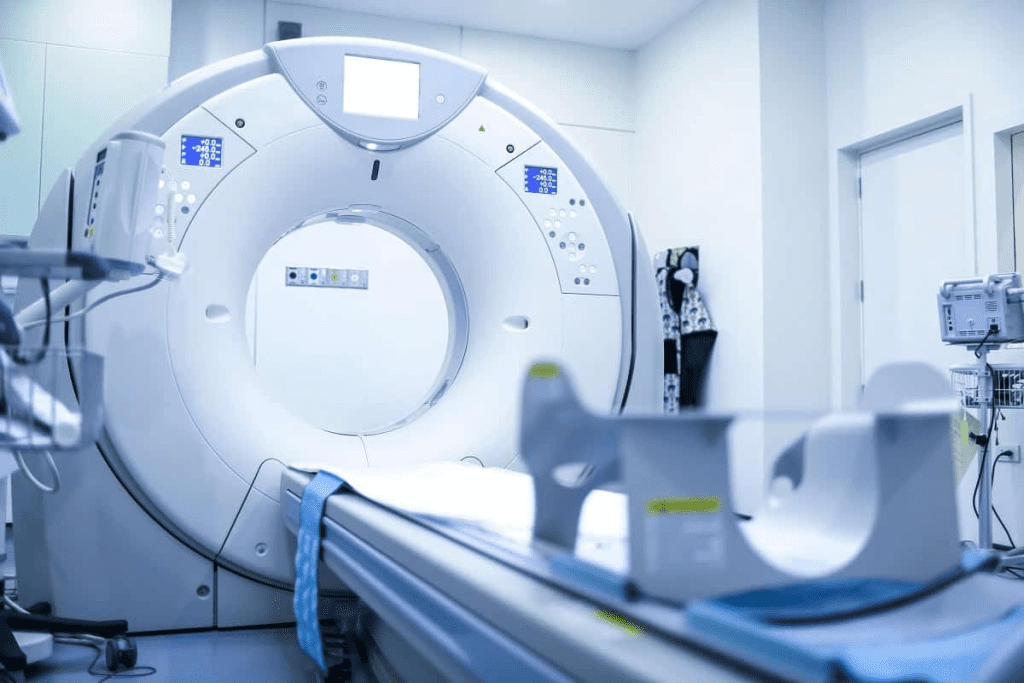Last Updated on November 25, 2025 by

We count on advanced imaging tests to find urinary tract diseases right. A CT urogram is a top tool for this job. It shows detailed pictures of the urinary system, like the kidneys, bladder, and ureters.
This test uses X-rays to make images. These images help spot problems like kidney stones, tumors, and cancer. Knowing how a CT urogram works helps us see its importance in medical care. It’s used in places like Liv Hospital for top-notch treatment.
The CT urogram procedure is a cutting-edge imaging method. It helps see the urinary system clearly. X-rays are used to make many images of the urinary tract. This gives detailed info about its shape and how it works.
CT urography is a test that uses CT scans to see the urinary system. It aims to find and track problems like bladder cancer, kidney stones, and blockages. Studies show it can spot bladder cancer up to 93% of the time according to recent research.
In a CT urogram, dye is injected into a vein to show the urinary tract. This dye makes problems stand out. The test takes many X-ray images, which are then turned into detailed 3D pictures.
Doctors suggest a CT urogram for blood in the urine or suspected urinary tract issues. It’s also for keeping an eye on those with past urinary problems. The main advantages of CT urography are:

CT urograms are key in spotting urinary tract issues. Their accuracy comes from their sensitivity and specificity. These numbers tell us how well CT urograms work in finding problems.
Sensitivity shows how well a test finds people with a disease. Specificity shows how well it finds people without a disease. CT urograms are very good at both, helping spot bladder cancer and other issues.
Key statistics include:
Positive Predictive Value (PPV) and Negative Predictive Value (NPV) are important, too. PPV tells us the chance that a positive test is correct. NPV tells us the chance that a negative test is correct.
Studies show CT urograms have a PPV of up to 98% and an NPV of 97%. This means they are very reliable.
New studies confirm CT urograms are very accurate. For example, a study on bladder cancer detection found high accuracy rates. This makes them a valuable tool for doctors.

Knowing these details helps doctors use CT urograms better. This improves patient care and results.
CT urograms are key in finding bladder cancer. They help us make accurate diagnoses. This is important for choosing the right treatment.
Research shows CT urograms can spot bladder cancer with up to 93% accuracy. This high sensitivity is vital for finding patients who need more tests and treatment. They let us see the urinary tract clearly, helping us find problems.
CT urograms also have specificity rates near 99%. This means they are very good at saying who doesn’t have bladder cancer. High specificity helps avoid extra tests and lowers patient stress.
Even though CT urograms are great, they can miss small tumors. Their sensitivity for small lesions is between 59% to 74%. This shows why we use them with other tests, like cystoscopy, for a full check.
We know CT urograms are powerful, but not the only tool. By knowing their strengths and weaknesses, we can give better diagnoses and treatments for bladder cancer patients.
CT urography is great for finding many urinary tract problems. It’s not just for bladder cancer. It helps find other issues, too.
CT urograms are top-notch for spotting kidney stones and blockages. They can find stones with over 90% accuracy. This helps doctors plan the best treatment.
CT urograms are also key for upper tract urothelial carcinomas. They help find these cancers early. This makes treatment planning easier.
CT urograms help find birth defects and unusual shapes in the urinary tract. They give clear images. This helps doctors make the right treatment plans.
Key Diagnostic Accuracy Rates:
In summary, CT urograms are very accurate for many urinary tract issues. They give detailed images. This helps doctors diagnose and treat kidney stones, cancers, and birth defects.
When looking at urinary tract issues, it’s key to see how CT urograms compare to other tests. This helps doctors pick the best test for each patient’s needs.
Cystoscopy is the best for finding bladder cancer because it lets doctors see and take biopsies directly. But, CT urograms are a non-invasive option that can spot bladder cancer well, even muscle-invasive types. Research shows CT urograms can find bladder cancer with up to 93% accuracy, though how well it does can vary, as recent studies show.
Ultrasound is often first for kidney checks because it’s safe and doesn’t use radiation. But, CT urograms give more detailed views of the urinary system, like finding stones or blockages. They’re better when the ultrasound isn’t clear or more detailed info is needed.
MRI urography is great for soft tissue details without radiation, which is good for some patients. But, it might not be as common as CT urograms, and how well it works can depend on the person doing the test.
In short, CT urograms have their benefits, but the right test depends on the situation, the patient, and what tests are available. Knowing how CT urograms compare to other tests helps doctors make better choices.
Knowing what affects CT urogram accuracy is key to understanding results. This diagnostic tool shows the urinary tract. Many things can change how reliable it is.
Things about the patient can really impact CT urogram accuracy. For example, some medical conditions or allergies to contrast dye can affect image quality. Also, moving during the scan can cause problems, making images less useful.
Technical and procedural aspects also play a big role. The time of the scan after contrast, the CT scanner’s quality, and the radiologist’s skill all matter. The CT urography protocol, like the contrast dose, also affects what can be seen.
Healthcare providers can improve CT urogram accuracy by understanding these factors. They can customize the procedure for each patient. They also need to focus on the technical details of the scan.
We’ve looked into how well CT urograms work in finding problems in the urinary tract. They are very good at spotting bladder cancer, kidney stones, and more. But it’s important to know their downsides.
CT urograms are great because they can find problems early and check the whole urinary tract. Yet, they use radiation and might not always be right. This means sometimes they might miss or find things that aren’t there.
When we look at CT urogram results, we need to think about both the good and the bad. A CT urogram or bladder CT can give us important clues. But we must remember that how well it works can depend on the patient and the test itself.
In real-world medicine, CT-urograms are a key tool for checking the urinary tract. Knowing their good points and bad points helps us use them better. This way, we can give our patients the best care possible.
A CT urogram is a detailed imaging test. It uses X-rays to show the urinary tract. This helps find problems like kidney stones, tumors, and cancer.
The test takes many X-ray images after the dye is injected into a vein. This dye makes the urinary tract stand out. It helps spot any issues.
Doctors suggest a CT urogram for hematuria or suspected urinary tract issues. This includes kidney stones or tumors.
CT urograms are very good at finding bladder cancer. They have high sensitivity and specificity rates. But they might miss small lesions.
Yes, CT urograms can spot other issues. This includes kidney stones, upper tract urothelial carcinomas, and congenital anomalies. They also show how severe these problems are.
CT urograms are non-invasive and provide detailed images. Cystoscopy is more direct but invasive. CT urograms might miss small lesions.
CT urograms have some downsides. They involve radiation, can have false results, and might miss small lesions. These should be considered when looking at the results.
Several factors can impact CT urogram accuracy. This includes patient health, allergies to dye, and technical aspects. The timing and equipment quality are also important.
While both use X-rays, a CT urogram focuses on the urinary tract. It uses dye to highlight the urinary system.
Certain conditions or allergies might prevent a CT urogram. This includes kidney disease or dye allergies. Always talk to your doctor first.
Subscribe to our e-newsletter to stay informed about the latest innovations in the world of health and exclusive offers!